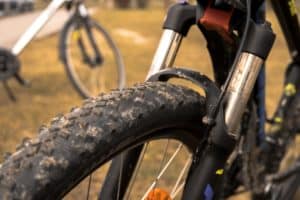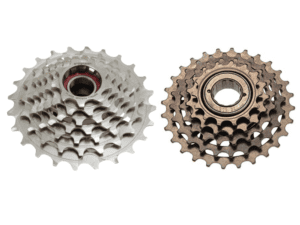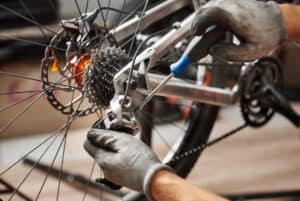Wondering which is the best option between tubeless and tubes for your mountain bike tires? Both systems are reliable and have their advantages and disadvantages. It’s all about the rider’s preferences at the end of the day.
Some riders prefer running on tubes, while others prefer tubeless tires. Experiment with both tube and tubeless options and see what works for you.
Tube vs Tubeless Tires
How Do Tubeless Tires Work?
Tubeless tire setups use no inner tubes. Instead, the rim, tire, and valve are sealed to keep in the air and prevent the wheel from getting a flat tire. There’s a liquid sealant that’s normally added to the inside of the tire to help prevent air leaks. If you intend to go tubeless, you have two options, namely:
· Use tubeless-ready wheels and rims, or,
· Use a tubeless conversion kit to change your current gear to tubeless.
Before putting up the pieces together, that’s if you go with the option of tubeless conversion kits, Seal your rims completely. You’ll need a tubeless valve, usually a sealed Presta valve. These valves with a removable core should be attached to your rim.
Apart from the tubeless valve, you’ll also need a tire that is tubeless compatible. Most tires are marked or indicated as tubeless-compatible on the sides. Other tires have the letters UST, which stands for “Universal System Tubeless.”
A UST tire doesn’t require a liquid sealant to remain airtight, but some people add some to be sure.
For most set-ups, the last and most important part is the liquid sealant. In case something punctures the tire, the sealant will quickly feel part and dry so that you can keep rolling. The sealant will eventually dry up or get used up, and you’ll need to add more.
Tube Tire Basics
Tube tire is the most popular system, even though the tubeless option is becoming a better option for many. The system is based on having an inner tube within the wheel, inflatable with air, and they have a hundred percent effect on your tire’s rolling performance.
Tubes are easy to repair and inexpensive to replace. You can even carry a spare tube in your tool kit. Tubes vary in size. Tube tires are lightweight, but they are bound to add a little weight when installing the inner tube.
Pros Tubeless Tires
You get Fewer Flats
This is the primary reason to go tubeless. Tubeless tires repair themselves whenever they get punctured. If a sharp stone, nail, or thorn punctures your tire, the liquid sealant inside will fill the hole before the air escapes.
No more stopping on your ride just because you suffered a puncture, find the levers and patch up your tube or replace it. When you see some little whitish fluid on your tire, know the tubeless system saved you from getting a flat.
When you hit a pothole or rock with your bike, the force is enough to compress your tire and hit the rim, and in the process, tear your tube. With the tubeless option, you don’t have a tube, and so you cannot suffer some ‘pinch flats,’ or ‘snake bites’ as often referred to. A bike will go thousands of miles without suffering a flat if you run on a tubeless option.
Sometimes you may get a large hole that the liquid sealant may not be able to seal. An internal patch will do the job. Duct tape, too, can be a temporary solution. A tubeless system will help you ride more and spend less money on tubes.
Superior Ride Quality
Tubeless tires allow you to lower tire pressure whenever you want to ride on a lower PSI. The benefits;
- You get better traction
- Enjoy better cornering
- You get a softer ride which means the wheel stays on the ground better, and you get faster with more control.
Flats are Easier to Repair
In a scenario where you run over a sizeable sharp rock and puncture your tire, sew it up with a needle and dental floss. You can do it all without the need to remove the tire from the rim.
Tubeless tire plugs are capable of repairing most punctures or tears. Otherwise, if it all fails, install a tube and complete the ride. It’s always advisable to carry one, just in case.
Lower Weight
Inner tubes have weight, so if you take them out of the picture, you’ll have less weight to push. You could save about half a pound if you don’t carry any tubes at all.
Saving weight around the wheels is more crucial than anywhere else on the bike. A heavier wheel adds rotational weight, which affects acceleration and creates a rolling resistance.
You Can Switch Back to Tubes
Just in case you don’t want to ride on tubeless anymore, for reasons only known to you, put the tubes back in. Remember to wash the sealant first and fit them in.
This is an excellent option if you run out of sealant or can’t find more at that moment. Before putting in the tube, check your tires for debris. Otherwise, the journey will end as soon as it started.
Going Tubeless is More Modern
If you are looking for the newest solution that most mountain bikers use right now, tubeless is the way to go. Tubeless tires, though expensive, they are built with high technology rubber.
Tubeless rims are lightweight and robust. The auto industry switched to tubeless years ago, and the cycling industry is on the same path.
Tubeless Tire Cons
Expensive to Run Tubeless
Tubeless tires and wheels are more expensive than the standard set meant for tubes. If your current gear cannot be converted to tubeless, you have no other option but to buy an entire tubeless set.
When you decide to change to tubeless for a system that can be converted, you’ll be forced to buy a tubeless valve, sealant, and rim tape. You’ll also be required to purchase a tubeless patch kit for fixing large holes or tears too big for your sealant to fill.
Tubeless Tires can Burp
A burp is a tubeless pinch flat. If you can crash in a high impact, the bead might separate and release some air. It can also come off the rim.
Coming off the rim is rare, but it does happen. The rear wheel might splash sealant in the air and even in your mouth. The sealant flavor is not so good.
They Take Longer to Mount
Installing tubeless tires can be pretty tricky, though enjoyable. The biggest challenge ever is settling the bead on the rim seat correctly.
The seal has to be correct. Otherwise, you will have done nothing. You also need to add sealant carefully, then pump in the air quickly.
Tubeless Gears is Not Available Everywhere
If you are touring developing countries or remote regions, finding tubeless accessories such as rim tape, sealant, tires, and patches might turn difficult.
Small bike shops don’t stock this equipment. In case you forgot your tool kit, you’ll be forced to switch to tubes.
You Will Still Need to Carry a Tube
In case a sealant fails to fill a hole, you will still need a spare tube as a backup. If you get a large puncture and the tire goes flat, that means the puncture was excessively big for the sealant to fix.
The whole sealant probably went through the hole. In this case, you’ll need a tube to get you home.
Sealant is Messy
Sealant is just a type of glue, and no glue tastes like apples or smells like roses. The sealant can splatter out of the tire if gashed and splash on your gears or clothes.
It can also mess up your hands when pouring it into the tire. The stuff is messy and unpleasant.
Tube Tires Pros
Running Them is Cheaper
Tubes are not selective. They are compatible with any tires and rims. Spare tubes and a set of patches are also very cheap. A good tube costs just a few dollars, and a patch kit goes for less than $5.
Plastic tire levers are cheap, and you need them whenever you need to patch up a puncture. That’s all you need with a tube setup.
They are Easier and Faster to Set-Up
It doesn’t take engineering skills to install a tube in a tire. It takes minutes to set up. Besides, you won’t have to mess around with sealants.
You won’t also have to worry about fixing your wheels correctly. It takes less effort to put a tire in a rim and no effort to install the tubes.
Tubes and Patches are Readily Available
If your tube or tubeless setup gets damaged, you can buy a replacement tube from most bike shops around the world. A tube may not be the quality you were looking for, but it will take you miles away before you can replace it again.
What’s more, many tubes are compatible. For example, you can use a 29” tube in a 27.5 tire if you have no alternative. Sealants for tubeless setup are only available in selected shops, unlike tubes and tires.
All Rims and Tires are Designed to Use Tubes
Even though most tires and rims are tubeless compatible, they can also use tubes.
You won’t have to hack around it to make it work. It’s as easy as your kid’s first school lesson.
Patching a Tube is Easy
Installing a tube is easy, and patching a tube is even easier. Almost every cyclist can do it. In case you don’t know how to, you can easily find someone to help you with it.
When it comes to a tubeless setup, only a few people know how to set them up and repair them. You may be on your own if you suffer a catastrophic tire tear or failure.
A Tube Repair Kit Light
All you need when repairing a flat is a patch kit, tire levels, and if required, some rubber glue. If the tube is torn, then you’ll have to use a spare tube.
You don’t have to carry super glue, plugs, a sewing kit, or sealant. For bicycle tourists, tubes are a better option because you won’t have to take a bulky tubeless tire repair kit with you.
Cons of Tubed Tires
Expect a Lot More Flats
The biggest problem with tubes is that you can get a flat more quickly. A tiny staple or piece of glass will force you off the trail.
If you ride in deserts, you’ll likely ride on thorns and get punctures, a few of them daily. You can invest in puncture protection tires to protect you from the mess.
The drawback of these kinds of tires is that they are heavier and harder to install on the rim. Another option is using a sealant that works like the tubeless sealant. It seals the tube puncture, and you won’t have to patch it up.
Handling is Harder with Tubes
You cannot run tubes on low pressure. Traction feels different. This is because not much of the tire makes contact with the ground. Traction is crucial in climbing and taking corners.
Your tires can slide if you take a very sharp corner on a loose surface. Your tires can also spin out if you pedal too hard. It’s for these reasons that many mountain bikers prefer tubeless tires.
Running Under Low Tire Pressure is a No!
If you ride on tubes at a low PSI, you risk suffering snake bites. It happens when you hit an object, and your tire bottom hits the rim. The incident causes two small holes resembling a snake bite.
The only way to prevent this from occurring is to ensure your tube is inflated to capacity. You’ll have to run your tires at 10 psi higher when running on tubes.
They’ll Make You Ride Slower
Since you cannot run on tubes at low tire pressure, your turns will not be as fast, or you will end up losing control. You can’t climb as quickly because your rear wheel risks spinning out.
Riding on tubes also makes acceleration slower because if you push the pedal hard, your rear wheel might spin out.
Tubes are Outdated
If you are the type of cyclist that prefers new things on their bikes, tubes are a bit dated. Most high-end bikes are coming with tubeless-ready wheels and tires.
Most companies are focusing on tubeless systems, and less engineering is focusing on tubed systems. For that one reason, tubes are still heavier.
Should I go Tubeless on My Mountain Bike?
If you ride your bike casually or occasionally, tubeless is not an option that you should consider much. The hassle and cost of setting one up are not worth it. The benefits are not necessary.
However, if you are an avid mountain biker who jumps on the bike every weekend or a serious rider, it would be best to run tubeless tires.
Some cyclists are totally against the idea of running tubeless, but it all depends on your preferences. You might run on tubeless, get a puncture and the sealant fails to seal the holes. However, a biker riding on tubes will patch more punctures than you will in a year.
FAQs
How much does it cost to shift to tubeless?
It depends on what you have. If your bike came with tubeless-ready wheels and tubeless vale supplied, then you’ll only have to buy some sealant which is a few tens of dollars.
If your tires and rims are already tubeless, but you don’t have a tubeless valve, you will need to buy a set for about a hundred dollars, and for a fancier and lighter set like Muc-Off, it will cost you a few hundred.
If your tires are not tubeless-ready, sealants will still work, but you will need much of it. However, if you decide a tubeless tire is a better option, expect to spend about a hundred dollars on a pair of tires, depending on the brand. If you don’t have tubeless-ready rims, it’s going to cost you more, up to a hundred dollars.
How big can a hole be?
Some small punctures refuse to seal sometimes due to puncture location. There have also been some scenarios where riders run over thorns and barely any air loss on their bikes.
Basically, most thorn holes, regardless of the size, will seal, but don’t unstick the thorns from the tire, especially if the thorns are big.





